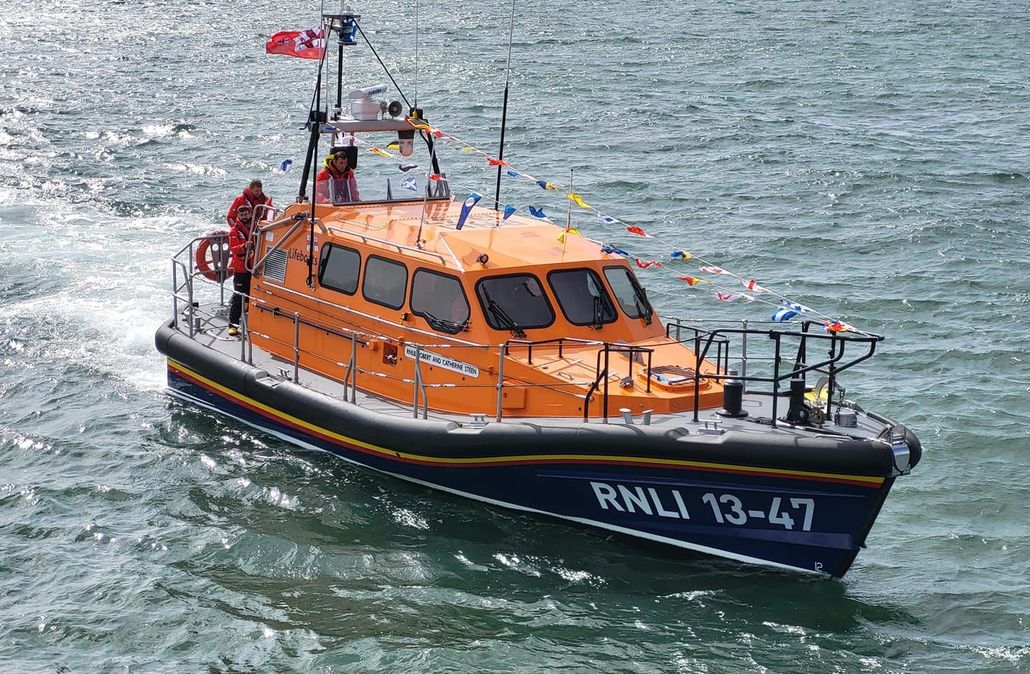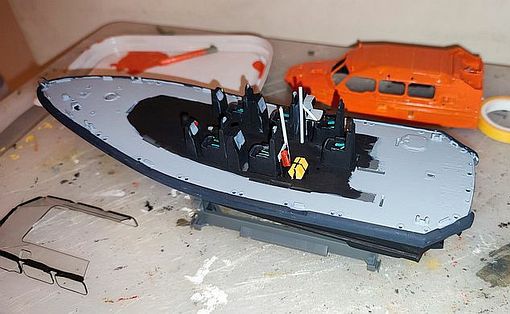October 2024 Part 1
RNLI Shannon Class Lifeboat
RNLB Robert & Catherine Steen 13-
RNLI Shannon Class Lifeboat
Anstruther Harbour, Kingdom of Fife, Scotland
Airfix 1/72
Developed by the RNLI's own design team, based on a proven pilot vessel design, the Shannon Class are being introduced around the UK to replace older Trent and Mersey Class lifeboats. Propelled and steered by water jets, allowing it to ground with reduced risk of damage, the Shannon is 13.6 Metres long and can sustain 27 knots of speed for 250 miles, subject to weather conditions. A large rubber fender protects it from damage when going alongside casualty vessels and an enclosed cabin with shock absorbing seats helps crew sustainability whilst transiting in bad weather.
For close in manoeuvring, an open bridge at the stern gives a clear view all around. The hull has been designed to reduce slamming and shaking in bad seas, with low freeboard along the sides to assist in recovering casualties.
Along with the new lifeboat comes a tracked launch system that can progress into
the water to launch or recover the lifeboat at all states of tide and by rotating
its carriage platform around, can re-
The RNLI is a volunteer organisation, funded entirely by donations from the public and relying on the commitment and bravery of its people.
Building the Airfix Shannon Class Lifeboat Kit:
Back in July, Airfix released this superb kit of the RNLI's latest Shannon Class
Lifeboat, currently being deployed around the British Isles*. The kit has been produced
in conjunction with the RNLI (and a proportion of the profits goes to them) to mark
the 200th Anniversary of its founding in 1824. 
It only comes as a Starter Kit, which unfortunately means you pay a premium for (quite a large bundle of less than useable) acrylic paint pots, a paint brush and a small tube of glue. It has clearly been designed by their Starter Kit team, as it features large open sprues, simplified assembly and some very well written instructions that explain (almost) everything that the infrequent modeller may need to know. Nevertheless, the level of detail is more than adequate and for those that want more, it provides an excellent basis for improvement. The dark grey plastic is quite hard, but not brittle, which helps removing the smaller parts from the sprue.
Clearly a lot of thought has gone into parts breakdown to help the less experienced, and although not "clip together", the general standard of parts fit is pretty high and should be within the reach of most purchasers, albeit that the railings and masts will need some patience. There was minimal flash (actually next to none), although some parts seemed to have a little mould misalignment (leaving a step on the part that was easily removed) .
*shame on me for not realising, despite more than 60 years of sailing, that the RNLI, its volunteers and its stations cover the entire British Isles, including the Republic Of Ireland, Channel Islands and the Isle of Man.
The kit needs to be painted in the RNLI house scheme of matt black undersides, gloss dark blue topsides, matt grey deck and gloss orange superstructure. Although Airfix provide their "Starter Kit" acrylic pots, I used proper enamels from Humbrol (white, black and greys), Xtracolour (midnight blue) and Revell (orange). To help with the orange coverage, I painted the superstructure white first with a thinned coat of enamel and to help with the dark blue, I painted the entire lower hull black to start with. (but note that some boats seem to have white lower surfaces). I assembled the hull and superstructure separately, as this eased painting and the attachment of the many small guardrails etc.
Inside the cabin, I added the distinctive blue restraining harnesses to the seats,
a chart table with additional display, coxswain's control panel, side partition and
a small liferaft, all based on the marvellous panoramic walkaround here https://www.panopticmotion.co.uk/virtual-
There are plenty of pictures of the real thing available on line, although you should note some further inconsistencies; I can see some boats with aluminium window frames although most of them seem to be black. Airfix seem to suggest (it's not entirely clear) that the cabin interior should be orange but checking online, it seems to be a matt black with grey panels. I also have at least one picture of a boat with a white/cream antifouling on the bottom instead of black.
The kit decals cover a boat of the RNLI Reserve Fleet, the RNLB Jock and  Annie Slater
(Admiral Sir Jock Slater having been one of my bosses in a past life when he was
Flag Officer Scotland & Northern Ireland and then Chief of Fleet Support), but Airfix
have also released an additional decal sheet that enables marking of any of the current
Shannon Boats, so that you can choose to represent your local vessel (I fully intend
to pass the unused markings on via e-
Annie Slater
(Admiral Sir Jock Slater having been one of my bosses in a past life when he was
Flag Officer Scotland & Northern Ireland and then Chief of Fleet Support), but Airfix
have also released an additional decal sheet that enables marking of any of the current
Shannon Boats, so that you can choose to represent your local vessel (I fully intend
to pass the unused markings on via e-
I have gone with the RNLB Robert & Catherine Steen, the current Anstruther Lifeboat (which formally entered service at the end of August 2024), as one that has some personal interest to me.
RNLI lifeboats are always kept pristine, so a careful and neat application of paint is essential, with next to no weathering (except for those on moorings that suffer from Seagull Strikes…..). I added a very small bit of oily washing to bring out the detail on hatches, but otherwise left it as it was. For the anchor, I added a small section of anchor chain (purchased as a piece of some very cheap jewellery from Claires! )
This is a superb little kit, raising awareness and a small amount of funding for one of our most important charities in its 200th year.
Throughout those 2 centuries, whenever anyone has gone anywhere on or in the sea around the British Isles, whatever the weather, these highly professional volunteers have had their back !


Below: The Anstruther Lifeboat is lifted out of the water at low tide on the tracked wading launch vehicle.
Now wouldn’t that make for a marvellous Airfix kit!


Below: RNLB Robert and Catherine Steen along with some of the many volunteers who operate the Anstruther Lifeboat Station. Behind is the previous lifeboat.

Photo Credit -






Below: RNLB Robert and Catherine Steen arrives at Anstruther for the first time, with the iconic Bass Rock pictured behind it on the southern side of the Firth of Forth.

Below: The added windscreen wipers, plus an anchor chain. Other than the simple additional detail that I added inside the cabin, the kit is entirely as supplied in the box.




